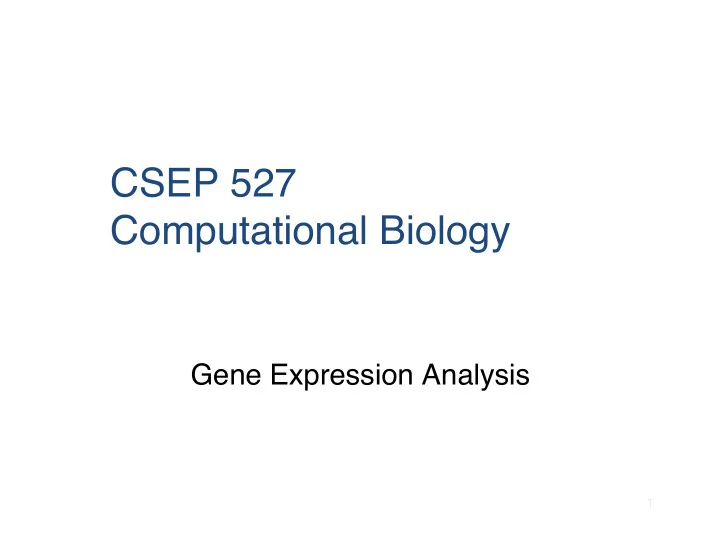

CSEP 527 Computational Biology Gene Expression Analysis 1
Assaying Gene Expression 3
Microarrays 4
⬇ RNAseq ⬇ ⬇ Millions of reads, DNA Sequencer say, 100 bp each map to genome, analyze 5
Goals of RNAseq #1: Which genes are being expressed? How? assemble reads (fragments of mRNAs) into (nearly) full-length mRNAs and/or map them to a reference genome #2: How highly expressed are they? How? count how many fragments come from each gene–expect more highly expressed genes to yield more reads, after correcting for biases like mRNA length #3: What’s same/diff between 2 samples E.g., tumor/normal #4: ... 7
Recall: splicing exon 5 ’ intron exon 2
RNAseq Data Analysis De novo Assembly mostly deBruijn-based, but likely to change with longer reads more complex than genome assembly due to alt splicing, wide diffs in expression levels; e.g. often multiple “k’s” used pro: no ref needed (non-model orgs), novel discoveries possible, e.g. very short exons con: less sensitive to weakly-expressed genes Reference-based (more later) pro/con: basically the reverse Both: subsequent bias correction, quantitation, differential expression calls, fusion detection, etc. 8
“TopHat” (Ref based example) n map reads to ref transcriptome (optional) BWA n map reads to ref genome n unmapped reads remapped as 25mers n novel splices = 25 mers anchored 2 sides n stitch original reads across these n remap reads with minimal overlaps n Roughly: 10m reads/hr, 4Gbytes (typical data set 100m–1b reads) 9
Kim,et al. 2013. “TopHat2: Accurate Alignment of Transcriptomes in the Presence of Insertions, Deletions and Gene Fusions.” Genome Biology 14 (4) (April 25): R36. doi:10.1186/gb-2013-14-4-r36. Figure 6
RNAseq Example 1yr-3 hg19 5 kb Scale chr19: 50,020,000 50,025,000 Day 20 1 Year FCGRT FCGRT 20
RNAseq protocol (approx) Extract RNA (either polyA ↔ polyT or tot – rRNA) Reverse-transcribe into DNA (“cDNA”) Make double-stranded, maybe amplify Cut into, say, ~300bp fragments Add adaptors to each end Sequence ~100-175bp from one or both ends CAUTIONS: non-uniform sampling, sequence (e.g. G+C), 5’-3’, and length biases 6
Two Stories: RNAseq Bias Correction & Isoform Quantification Let-7 & Cardiomyocyte Maturation Walter L. (Larry) Ruzzo Computer Science and Engineering Genome Sciences University of Washington Fred Hutchinson Cancer Research Center Seattle, WA, USA Copenhagen, 2015-Aug-18 ruzzo@uw.edu
Story 1 RNAseq: Bias Correction & Alt Splicing
“All High-Throughput Technologies are Crap – Initially” Q. Morris 7-20-2015
RNA seq cDNA, fragment, QC filter, RNA → → S equence → → C ount end repair, A-tail, trim, map, ligate, PCR, … … It’s so easy, what could possibly go wrong?
What we expect: Uniform Sampling 100 Count reads starting at each position, not those covering each position 75 50 25 0 0 50 100 150 200 Uniform sampling of 4000 “reads” across a 200 bp “exon.” Average 20 ± 4.7 per position, min ≈ 9, max ≈ 33 I.e., as expected, we see ≈ μ ± 3 σ in 200 samples
What we get: highly non-uniform coverage The bad news : random fragments are not so uniform. E.g., assuming uniform, the 8 peaks above 100 are > +10 σ above mean ~ Count reads starting at Uniform each position, not those 50 25 covering each position 0 Actual ––––––––––– 3’ exon ––––––––– 200 nucleotides Mortazavi data
What we get: highly non-uniform coverage The bad news : random fragments are not so uniform. E.g., assuming uniform, the 8 peaks above 100 are > +10 σ above mean ~ Count reads starting at Uniform each position, not those 50 25 covering each position 0 Actual How to make it more uniform? A: Math tricks like averaging/smoothing (e.g. “coverage”) or transformations (“log”), …, or WE DO B: Try to model (aspects of) causation ––––––––––– 3’ exon ––––––––– THIS 200 nucleotides Mortazavi data
What we get: highly non-uniform coverage The Good News : we can (partially) correct the bias The bad news : random fragments are not so uniform. Uniform 50 25 0 Actual not perfect, but better: 38% reduction in LLR of uniform model; hugely more likely 200 nucleotides
(in part) Bias is ^ sequence-dependent Reads and platform/sample-dependent Fitting a model of the sequence surrounding read starts lets us predict which positions have more reads.
d sample foreground sequences o ( a ) h e t n e i M l t sample (local) background sequences ( b ) u O train Bayesian network ( c ) I.e., learn sequence patterns associated w/ high / low read counts. ( d ) ( e )
Modeling Sequence Bias Want a probability distribution over k-mers, k ≈ 40? Some obvious choices: Full joint distribution: 4 k -1 parameters PWM (0-th order Markov): (4-1)•k parameters Something intermediate: Directed Bayes network 12
Form of the models: Directed Bayes nets One “node” per nucleotide, ±20 bp of read start • Filled node means that position is biased • Arrow i → j means letter at position i modifies bias at j • For both, numeric parameters say how much How–optimize: n n Pr [ s i | x i ] Pr [ x i ] � � ℓ = logPr [ x i | s i ]= log � x ∈ { 0 , 1 } Pr [ s i | x ] Pr [ x ] i = 1 i = 1
NB: •Not just initial hexamer •Span ≥ 19 •All include Illumina ABI negative positions •All different, even on same platform
Result – Increased Uniformity Kullback-Leibler Divergence Jones Li et al Hansen et al Trapnell Data
Result – Increased Uniformity R 2 Fractional improvement in log-likelihood under hypothesis test: uniform model across * = p-value < 10 -23 “Is BN better than X?” 1000 exons (R 2 =1-L’/L) (1-sided Wilcoxon signed-rank test)
“First, do no harm” Theorem: The probability of “false bias discovery,” i.e., of learning a non-empty model from n reads sampled from unbiased data, declines exponentially with n. Prob(non-empty model | unbiased data) If > 10,000 reads are used, the probability of a non-empty model < 0.0004 10 4 17 Number of training reads
Recommend
More recommend